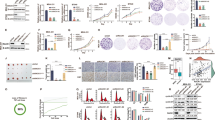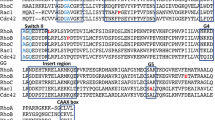Abstract
A novel splice variant of Rac1, designated Rac1b, is expressed in human breast and colon carcinoma cells. Rac1b contains an additional 19 amino-acid insert immediately behind the switch II domain, a region important for Rac1 interaction with regulators and effectors. Recent studies showed that Rac1b exhibited the biochemical properties of a constitutively activated GTPase, yet it showed impaired interaction with downstream effectors, suggesting that Rac1b may be defective in biological activity. Whether Rac1b is a biologically active protein was not addressed. Therefore, we evaluated the biochemical, signaling and growth-promoting properties of authentic Rac1b. Similar to previous observations, we found that Rac1b showed enhanced intrinsic guanine nucleotide exchange activity, impaired intrinsic GTPase activity, and failed to interact with RhoGDI. Surprisingly, we found that Rac1b, like the constitutively-activated and transforming Rac1(Q61L) mutant, promoted growth transformation of NIH3T3 cells. Rac1b-expressing cells also showed a loss of density-dependent and anchorage-dependent growth. Surprisingly, unlike activated Rac1(61L), Rac1b did not show enhanced activation of the nuclear factor κB (NF-κB) transcription factor or stimulate cyclin D1 expression, the signaling activities that best correlate with Rac1 transforming activity. However, Rac1b did promote activation of the AKT serine/threonine kinase. Therefore, we suggest that Rac1b selectively activates a subset of Rac1 downstream signaling pathways to facilitate cellular transformation.
This is a preview of subscription content, access via your institution
Access options
Subscribe to this journal
Receive 50 print issues and online access
$259.00 per year
only $5.18 per issue
Buy this article
- Purchase on Springer Link
- Instant access to full article PDF
Prices may be subject to local taxes which are calculated during checkout







Similar content being viewed by others
References
Albanese C, Johnson J, Watanabe G, Eklund N, Vu D, Arnold A and Pestell RG . (1995). J. Biol. Chem., 270, 23589–23597.
Bar-Sagi D and Hall A . (2000). Cell, 103, 227–238.
Bishop AL and Hall A . (2000). Biochem. J., 348 (Part 2), 241–255.
Boettner B and Van Aelst L . (2002). Gene, 286, 155–174.
Booden MA, Campbell SL and Der CJ . (2002). Mol. Cell Biol., 22, 2487–2497.
Clark GJ, Westwick JK and Der CJ . (1997). J. Biol. Chem., 272, 1677–1681.
Coniglio SJ, Jou TS and Symons M . (2001). J. Biol. Chem., 276, 28113–28120.
Engers R, Zwaka TP, Gohr L, Weber A, Gerharz CD and Gabbert HE . (2000). Int. J. Cancer, 88, 369–376.
Etienne-Manneville S and Hall A . (2002). Nature, 420, 629–635.
Fiegen D, Haeusler LC, Blumenstein L, Herbrand U, Dvorsky R, Vetter IR and Ahmadian MR . (2003). J. Biol. Chem., 279, 4743–4749.
Galang CK, Garcia-Ramirez J, Solski PA, Westwick JK, Der CJ, Neznanov NN, Oshima RG and Hauser CA . (1996). J. Biol. Chem., 271, 7992–7998.
Grizot S, Faure J, Fieschi F, Vignais PV, Dagher MC and Pebay-Peyroula E . (2001). Biochemistry, 40, 10007–10013.
Hill CS, Wynne J and Treisman R . (1995). Cell, 81, 1159–1170.
Ihara K, Muraguchi S, Kato M, Shimizu T, Shirakawa M, Kuroda S, Kaibuchi K and Hakoshima T . (1998). J. Biol. Chem., 273, 9656–9666.
Jaffe AB and Hall A . (2002). Adv. Cancer Res., 84, 57–80.
Jordan P, Brazao R, Boavida MG, Gespach C and Chastre E . (1999). Oncogene, 18, 6835–6839.
Joyce D, Bouzahzah B, Fu M, Albanese C, D'Amico M, Steer J, Klein JU, Lee RJ, Segall JE, Westwick JK, Der CJ and Pestell RG . (1999). J. Biol. Chem., 274, 25245–25249.
Karnoub AE, Worthylake DK, Rossman KL, Pruitt WM, Campbell SL, Sondek J and Der CJ . (2001). Nat. Struct. Biol., 8, 1037–1041.
Keely PJ, Westwick JK, Whitehead IP, Der CJ and Parise LV . (1997). Nature, 390, 632–636.
Khosravi-Far R, Solski PA, Clark GJ, Kinch MS and Der CJ . (1995). Mol. Cell Biol., 15, 6443–6453.
Kimple RJ, Jones MB, Shutes A, Yerxa BR, Siderovski DP and Willard FS . (2003). Comb. Chem. High Throughput Screen, 6, 399–407.
Lambert JM, Lambert QT, Reuther GW, Malliri A, Siderovski DP, Sondek J, Collard JG and Der CJ . (2002). Nat. Cell Biol., 4, 621–625.
Lin R, Cerione RA and Manor D . (1999). J. Biol. Chem., 274, 23633–23641.
Malliri A, van der Kammen RA, Clark K, van der Valk M, Michiels F and Collard JG . (2002). Nature, 417, 867–871.
Matos P, Collard JG and Jordan P . (2003). J. Biol. Chem., 278, 50442–50448.
Michaelson D, Silletti J, Murphy G, D'Eustachio P, Rush M and Philips MR . (2001). J. Cell Biol., 152, 111–126.
Minden A, Lin A, Claret FX, Abo A and Karin M . (1995). Cell, 81, 1147–1157.
Moon SY and Zheng Y . (2003). Trends Cell Biol., 13, 13–22.
Qiu RG, Chen J, Kirn D, McCormick F and Symons M . (1995). Nature, 374, 457–459.
Ridley AJ . (2001). Trends Cell Biol., 11, 471–477.
Roux P, Gauthier-Rouviere C, Doucet-Brutin S and Fort P . (1997). Curr. Biol., 7, 629–637.
Rul W, Zugasti O, Roux P, Peyssonnaux C, Eychene A, Franke TF, Lenormand P, Fort P and Hibner U . (2002). Ann. NY Acad. Sci., 973, 145–148.
Sahai E and Marshall CJ . (2002). Nat. Rev. Cancer, 2, 133–142.
Schnelzer A, Prechtel D, Knaus U, Dehne K, Gerhard M, Graeff H, Harbeck N, Schmitt M and Lengyel E . (2000). Oncogene, 19, 3013–3020.
Seraj MJ, Harding MA, Gildea JJ, Welch DR and Theodorescu D . (2000). Clin. Exp. Metast., 18, 519–525.
Sulciner DJ, Irani K, Yu ZX, Ferrans VJ, Goldschmidt-Clermont P and Finkel T . (1996). Mol. Cell Biol., 16, 7115–7121.
Tapon N, Nagata K, Lamarche N and Hall A . (1998). EMBO J., 17, 1395–1404.
Tolkacheva T, Feuer B, Lorenzi MV, Saez R and Chan AM . (1997). Oncogene, 15, 727–735.
Van Aelst L and D'Souza-Schorey C . (1997). Genes Dev., 11, 2295–2322.
Van Aelst L and Symons M . (2002). Genes Dev., 16, 1032–1054.
van Leeuwen FN, van der Kammen RA, Habets GG and Collard JG . (1995). Oncogene, 11, 2215–2221.
Vetter IR and Wittinghofer A . (2001). Science, 294, 1299–1304.
Wennerberg K, Ellerbroek SM, Liu RY, Karnoub AE, Burridge K and Der CJ . (2002). J. Biol. Chem., 277, 47810–47817.
Westwick JK, Lambert QT, Clark GJ, Symons M, Van Aelst L, Pestell RG and Der CJ . (1997). Mol. Cell Biol., 17, 1324–1335.
Worthylake DK, Rossman KL and Sondek J . (2000). Nature, 408, 682–688.
Xu X, Wang Y, Barry DC, Chanock SJ and Bokoch GM . (1997). Biochemistry, 36, 626–632.
Acknowledgements
We thank J Chernoff and M Philips for providing plasmid constructs. Our research was supported by grants from the National Institutes of Health (NIH) to CJD (CA63071) and to JS (GM62299).
Author information
Authors and Affiliations
Corresponding author
Rights and permissions
About this article
Cite this article
Singh, A., Karnoub, A., Palmby, T. et al. Rac1b, a tumor associated, constitutively active Rac1 splice variant, promotes cellular transformation. Oncogene 23, 9369–9380 (2004). https://doi.org/10.1038/sj.onc.1208182
Received:
Revised:
Accepted:
Published:
Issue Date:
DOI: https://doi.org/10.1038/sj.onc.1208182
Keywords
This article is cited by
-
Novel rapid immunohistochemistry using an alternating current electric field identifies Rac and Cdc42 activation in human colon cancer FFPE tissues
Scientific Reports (2022)
-
RAC1B modulates intestinal tumourigenesis via modulation of WNT and EGFR signalling pathways
Nature Communications (2021)
-
Blockade of ARHGAP11A reverses malignant progress via inactivating Rac1B in hepatocellular carcinoma
Cell Communication and Signaling (2018)
-
The Rac1 splice form Rac1b favors mouse colonic mucosa regeneration and contributes to intestinal cancer progression
Oncogene (2018)
-
The COSMIC Cancer Gene Census: describing genetic dysfunction across all human cancers
Nature Reviews Cancer (2018)



